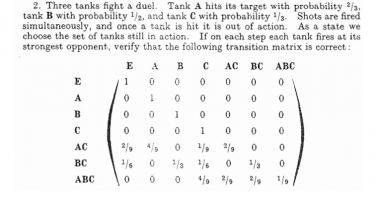PLEASE HELP!!
- Thread starter Georgmil
- Start date
blamocur
Elite Member
- Joined
- Oct 30, 2021
- Messages
- 3,211
The way I'd interpret it: row and column labels show which tanks are left. Initially it is ABC, and AC means B is out but A and C are still there. There is no BC state because in ABC state nobody fires at C. The number at the intersection of row labeled S1 and column S2 shows the probability of the transition from state S1 to state S2. For example, probability of getting from BC to AC is 0 because in the BC state the A tank is already out, but you can get to the C state if tank C hits tank B.
Now you need to verify that the probabilities of those transitions in your matrix are correct.
Now you need to verify that the probabilities of those transitions in your matrix are correct.
Thank you for your answer. But, how would you interpret for example cross of AC and A, or AC and AC?The way I'd interpret it: row and column labels show which tanks are left. Initially it is ABC, and AC means B is out but A and C are still there. There is no BC state because in ABC state nobody fires at C. The number at the intersection of row labeled S1 and column S2 shows the probability of the transition from state S1 to state S2. For example, probability of getting from BC to AC is 0 because in the BC state the A tank is already out, but you can get to the C state if tank C hits tank B.
Now you need to verify that the probabilities of those transitions in your matrix are correct.
blamocur
Elite Member
- Joined
- Oct 30, 2021
- Messages
- 3,211
The transition from AC to A means that there were two tanks (A & C) but only A survives the round, i.e, C hits A and A misses. And the transition from AC to AC means that they they both miss.Thank you for your answer. But, how would you interpret for example cross of AC and A, or AC and AC?
Do you know how to compute the probabilities of such events?
Thank you very much! Really, thank you a lot! Now i understand, and know how to compute!The transition from AC to A means that there were two tanks (A & C) but only A survives the round, i.e, C hits A and A misses. And the transition from AC to AC means that they they both miss.
Do you know how to compute the probabilities of such events?
Steven G
Elite Member
- Joined
- Dec 30, 2014
- Messages
- 14,591
Did you make a mistake there or am I missing something (probably missing something)? If A survives the round, then wouldn't it be that A hits C and C misses??The transition from AC to A means that there were two tanks (A & C) but only A survives the round, i.e, C hits A and A misses.
blamocur
Elite Member
- Joined
- Oct 30, 2021
- Messages
- 3,211
You are right, I got it backwards -- thanks for pointing it out.Did you make a mistake there or am I missing something (probably missing something)? If A survives the round, then wouldn't it be that A hits C and C misses??

